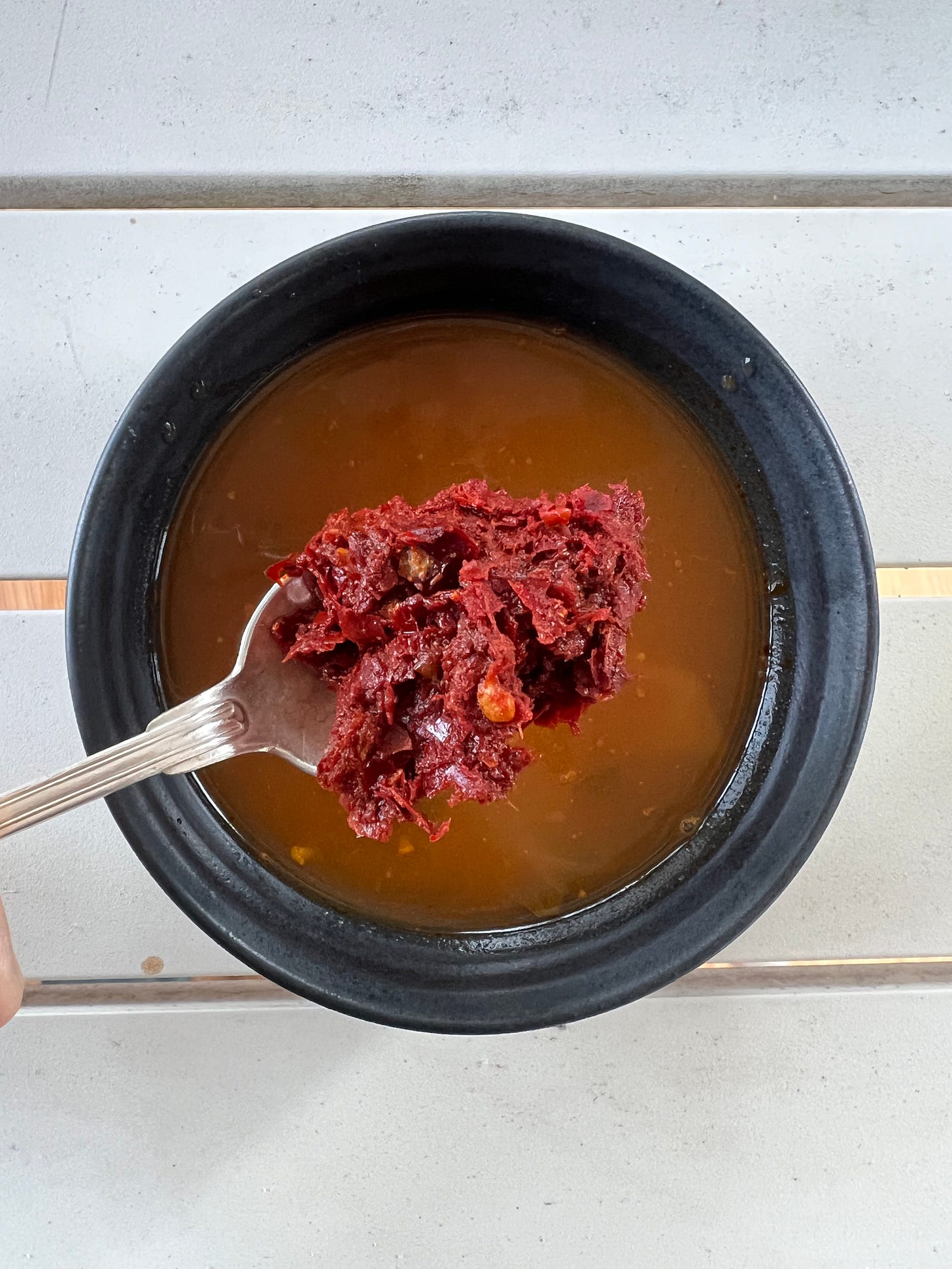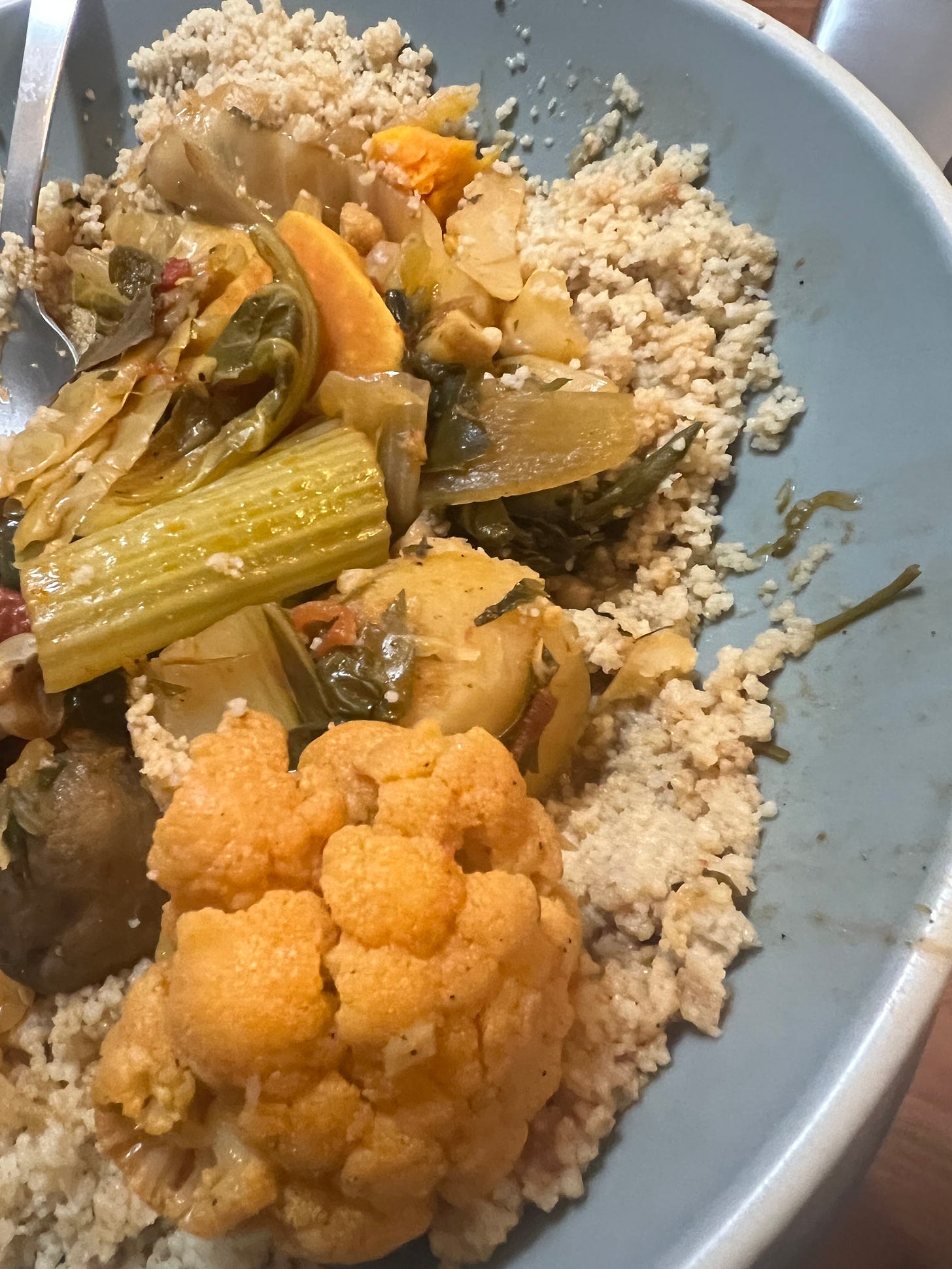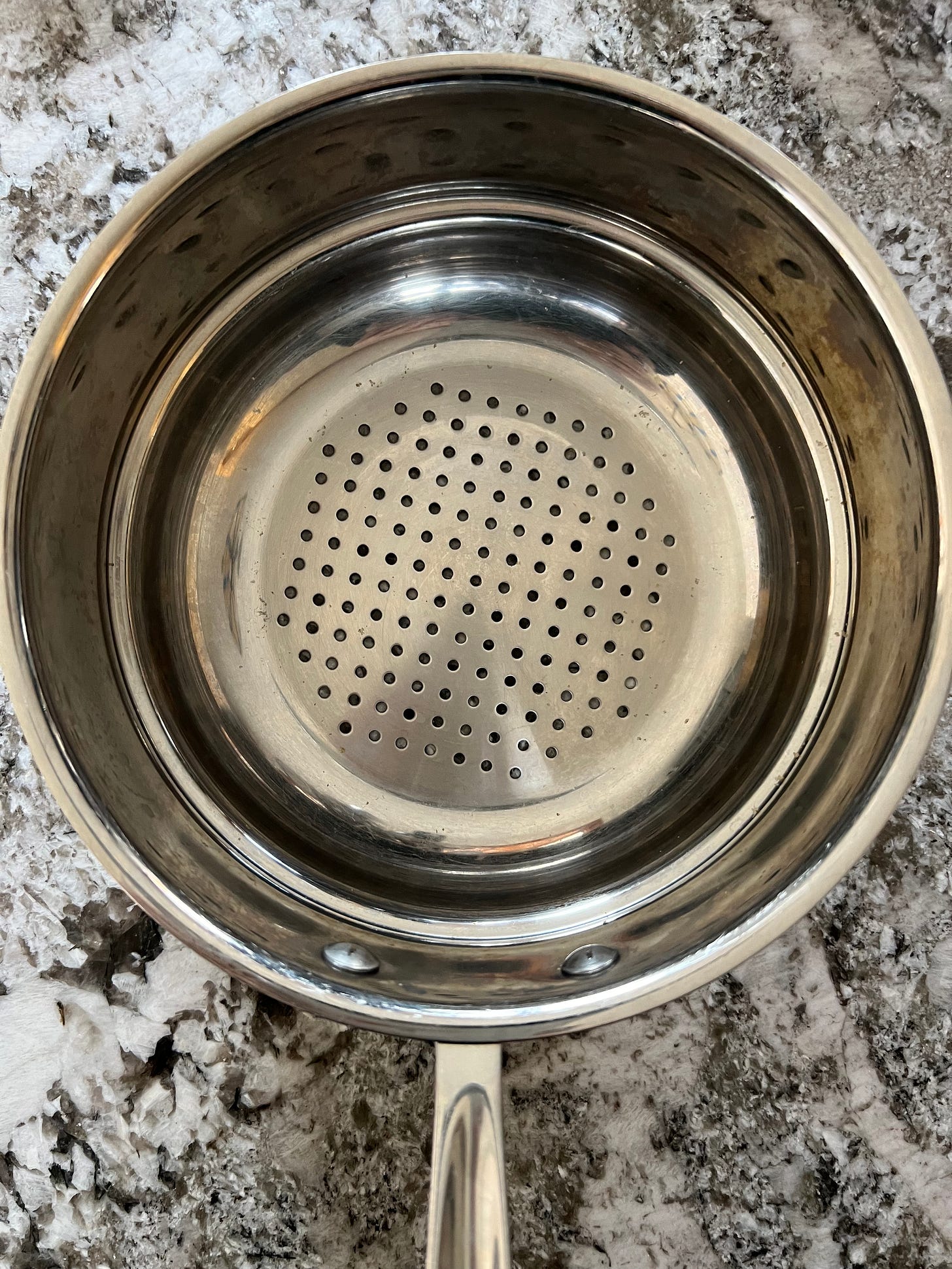Issue #146: A Vegetarian Couscous
Some Couscous Advice, Misinformation Corrected, An Impressive Dish
This post has been updated to indicate that Paul Wolfert is still very much alive. So sorry for the error. And so grateful for her contribution to our understanding of the food of the Maghreb and so many other wonderfully delicious places.
A vegetarian couscous is a relatively quick, impressive, satisfying dish that can be made with whatever vegetables you have on hand. It answers a lot of needs—for something celebratory, something filling, something vegan, something flavorful, and even something kosher.
Such were our needs the other night, when we had our friends Aren and Magnolia visiting from Manhattan. And although at some point I must have given away the couscousière and hand-painted couscous serving bowls I lugged back from Tunisia more than thirty years ago, you don’t need anything beyond a good, sturdy pot and a steamer insert to make a delicious vegetarian feast.
“Steam Your Couscous!”
A word about that steamer. With me and many others on that olive-oil trip to Tunisia was also Paula Wolfert, an expert on the foods of the Maghreb. I recall that at every opportunity Paula would ask any chef or cook we met to explain the “right and only way” to cook couscous. Despite the instructions on virtually every package of couscous sold in the world to simply add hot water, cover, let sit, and fluff with a fork, Paula insisted, as did her unexpected corroborators, that those instructions were simply the first step in cooking couscous—yes, even those labeled “instant.” In order to make it more delicious and more digestible, she implored, after the first fork fluffing, the couscous needed to be spread out on a tray, rubbed with olive oil, and then steamed for twenty minutes at least once and preferably three times.
Although this additional step seems like it turns five-minute, instant couscous into a protracted production, a good steam or two is really not that difficult to handle and you can do it in the time it takes for the vegetables to cook. (Steaming is also not necessary, but in deference to Paula, I personally wouldn’t dare skip it. And it does produce a more delicate result.) The design of that traditional couscousière I can’t find allows for this method. It is comprised of a large, tapered pot for the stew topped with a perforated steamer. But in fact, I find it easier to steam the couscous in a separate pot over water and thereby keep the couscous warm while I maintain a watchful eye on the stew so that I don’t overcook all the vegetables to mush.
If you have a steamer or colander that fits over any pot, you can use it. Although it might look like the couscous grains will fall through the perforations, once rehydrated and fluffed, they clump enough to prevent escape. If you are still worried or if your steamer is particularly porous, you can line it with cheesecloth or even a thin, clean dishtowel. Top it with another clean dish towel to absorb any moisture that condenses on the lid; the point of steaming is to make the couscous dry, light, and fluffy, not heavy and sodden. Keep the couscous hot over simmering water until you are ready to serve.

Misinformation Is Rampant
There’s plenty of other misinformation about couscous, for instance, that it is itself a distinct grain. It is not. Couscous is made from durum wheat semolina, a type of hard wheat that is also used to make pasta in Italy. It would be more accurate to designate couscous a relative of pasta rather than a grain, but that would likely land it on the grocery store shelf next to linguine and fettuccine, where stockists would worry it might make shoppers uncomfortable. Instead, you’ll likely find it marginalized with other “ethnic and exotic” ingredients. (Note whose comfort is of more concern.) Interestingly, I find whole wheat couscous lighter and more flavorful than the more common one made with refined semolina.
I’ve seen people all over the world—Tunisia, Paris, Tel Aviv, New York—make couscous from scratch, a process that begins with larger granules of semolina moistened with water and rolled by hand with finer semolina to make tiny pellets. It is labor intensive and so not often done, though I’ve tried it myself and there’s a pleasing, meditative quality to the process. You can find instructions on how to do it here.
Finally, yes, couscous is both the name of the fluffy stuff and the entire dish. When I lived in Paris as a Junior in college, one of our favorite places to celebrate birthdays was a Moroccan restaurant in Paris’s Fifth Arrondissement where their Couscous Royale came to the table with a platter of stewed meats and merguez sausage aflame with sparklers, so I guess couscous is also a celebration.
About the Stew
As for the stew, the point here is to create a generous, flavorful broth studded with various types of properly cooked vegetables that’s redolent of spice but not overpowered by it. Moroccan food is not Indian food and the temptation to season the broth like a curry should be restrained. The combination of vegetables I use depends on what I have. I like to use some root vegetables (chunks of carrot, parsnip, celery root, turnip, sweet and regular potatoes), some cruciferous ones (wedges of cabbage, brussels sprouts, cauliflower florets), and some lighters ones (zucchini, yellow squash, eggplant, celery, and/or mushrooms).
For the spices, a combination of cumin, coriander, ginger, garlic, paprika, chili, cinnamon, and bay. A handful of cooked chickpeas or other beans is also welcome to the pot. (Some lamb shoulder, chicken, and/or merguez are very welcome, too, if you aren’t cooking for vegetarians, but that’s another thing, entirely. If you want to add meats to your couscous, braise them in the cooking liquid until tender before you begin to add the vegetables.)
To Serve
I like to garnish my couscous traditionally, with wedges of preserved lemon and spicy harissa, which is traditionally mixed into a small bowl of the broth and spooned over the dish before eating. Sparklers are optional.
Because this is a sort of catch-all, clean-the-fridge dish, it feels funny to write a recipe. I rarely refer to one. But I offer you an outline of my approach.

RECIPE: Vegetarian Couscous
Serves 6 to 8 with leftovers
4 tablespoons extra-virgin olive oil, plus additional for the couscous
1 large onion, thinly sliced
Salt
2 large cloves garlic, minced
1 large knob ginger, minced
1 teaspoon ground cumin
1 teaspoon ground coriander
1 teaspoon ground paprika
1/2 teaspoon Kashmiri chili or similar mild pepper
1/4 teaspoon turmeric
1/4 teaspoon ground cinnamon
Pinch cardamom
1 28-ounce can whole tomatoes
1 bay leaf
1 2-inch stick cinnamon
Freshly ground black pepper
2 carrots, peeled and cut into chunks
About 1 pound starchy vegetables, such as parsnip, celery root, sweet potato, turnip, butternut squash chunks, and/or white potato, peeled
About 1/2 cup cooked chick peas
About 1 pound cruciferous vegetables, such as green cabbage cut into wedges, brussels sprouts, and/or large cauliflower florets
About 1 pound lighter vegetables, such as zucchini or summer squash, celery, fennel, and/or white mushrooms
1 1/2 cups whole wheat or regular couscous
For the garnish
Chopped flat-leaf parsley
Preserved lemon
Harissa
In a large, heavy pot (I use an 8-quart Le Creuset Dutch oven), heat the olive oil over medium-high heat. Add the onion and a pinch of salt and cook until soft, 4 or 5 minutes. Add the garlic and ginger and cook another couple of minutes until fragrant. Add the cumin, coriander, paprika, chili, turmeric, cinnamon, and the cardamom, and cook another minute or so until the spices have gently toasted. Add the tomatoes with their liquid along with two cans of water, bay leaf, cinnamon stick, another large pinch of salt, and a generous amount of freshly ground black pepper. Bring to a boil, reduce the heat to a simmer, set the cover ajar, and let simmer about 10 minutes for the flavors to come together.
Add the carrots and any starchy vegetables you are using. Push them down so they are submerged in the cooking liquid, set the cover ajar, and simmer 10 minutes or so. Add the cruciferous vegetables, except any cauliflower, if using, and let simmer another 10 minutes. Add the lighter vegetables along with any cauliflower and let simmer another 10 minutes. Taste and adjust the seasoning. Cook until the vegetables are done.
Meanwhile, prepare the couscous. Place the couscous in a medium bowl with a pinch of salt. If using whole wheat couscous, add 3 cups boiling water; if using regular couscous, add two cups boiling water. Cover the bowl and let sit for about 5 minutes. Fluff with a fork.
Bring about 3-inches of water to boil in a pot with a tight-fitting steamer insert and lid. Lightly grease a baking sheet with olive oil. Spread the fluffed couscous out on the greased pan. Drizzle additional oil over the couscous and using your hands or a rubber spatula, toss and rub the couscous to lightly oil the grains. Transfer the couscous to the steamer insert and set over the boiling water—make sure it isn’t touching the water. Reduce the heat to a simmer. Lay a clean dish towel on top, cover tightly, and let steam 20 to 30 minutes, until light and fluffy.
The couscous should be ready by the time the vegetables are done. To serve, transfer the couscous to a large, wide serving bowl, making a well in the center. With a slotted spoon, pile the cooked vegetables in the well. Ladle some of the cooking liquid over the vegetables and over the couscous. Garnish with chopped parsley and wedges of preserved lemon. Serve with a pitcher of the broth, into which diners can stir as much harissa as they want to sauce their own portion.






Yes. Thank you. She is, indeed. Apologies to all, especially Paula. Appreciate the correction.
I think Paula is still with us :)